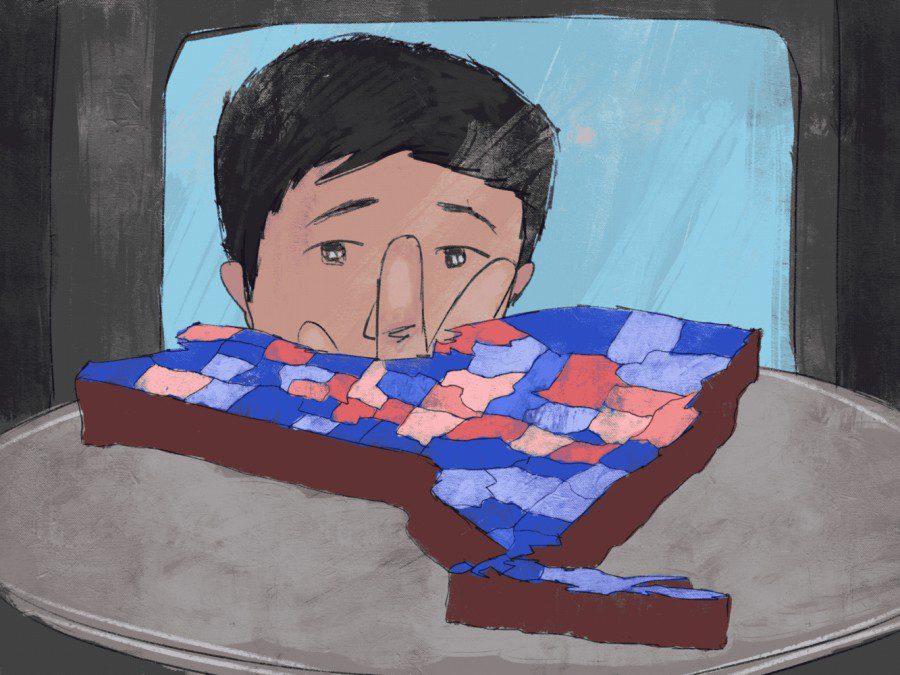Opinion: The red wave did hit New York. Is this the new normal?
New York Republicans made immense gains during the midterm elections. But the results are far from the country’s status quo, where Democrats staved off a greater Republican takeover of congressional seats.
New York’s blue state identity should not be taken for granted. (Illustration by Vedang Lambe)
November 23, 2022
If you are the type of person who says “My vote doesn’t matter in New York,” consider yourself wrong. It seems that as the dust settles following this year’s midterm elections, New York was home to more than a few of the election’s most decisive and resounding Republican wins. I would even go as far as to say that the biggest reason Republicans narrowly won the majority back in the U.S. House of Representatives was because of their outstanding showing in the Empire State.
Republicans won all four congressional district seats in Long Island, two of the three seats up for grabs in the Hudson Valley and a crucial toss-up district in Central New York. In total, Republicans flipped four seats in the 3rd, 4th, 17th and 19th congressional districts, and easily held others that Democrats thought would be straightforward to win over.
This result was not the broader outcome across the country. Republicans failed to flip a Senate that seemed like a fair toss-up before Election Day, and barely scraped by with the House — which was projected to be an easy takeover. So why was New York different? What can be said about the four districts Republicans flipped across the state?
I previously argued for WSN that New York would be facing a redder future. Suburban voters in Long Island and the Hudson Valley were primarily concerned with inflation and crime, which are both keystones of the Republican platform in the state. This strategy proved to be very effective, especially within the inner suburbs of New York City, where high populations of Orthodox Jewish voters turned out in droves for Republicans.
This voting bloc was a driving force behind a surprising Republican win for Congressmember-elect Anthony D’Esposito after a tight race for the 4th District — which encompasses the Jewish enclave in Five Towns. A former police officer and detective for the New York City Police Department, D’Esposito reassured the electorate by focusing his campaign on crime prevention. D’Esposito won a district that Biden held by 14 percentage points in 2020.
Congressmember-elect Mike Lawler had a similarly shocking win in the 17th congressional district, which boasts a large number of ultra-Orthodox Jewish communities in Rockland County. He narrowly defeated Sean Patrick Maloney, the chair of the Democratic Congressional Campaign Committee, who had served five consecutive terms. Maloney’s loss was so profoundly disappointing to the state’s democratic establishment that it even warranted its own news category under The New York Times’ midterm coverage.
Lawler repeatedly bashed Maloney for being out of touch with the general public, accusing him of being a member of a political machine that didn’t care about voters who were struggling to pay their costly bills. But deeming the Democratic governing of the state as inept was not the challenge for Republicans. Those in Democrat-heavy districts needed to work toward a more centrist platform to capture the slim margins that gave them victories. In a calculated move, Lawler distanced himself from Jan. 6 insurrection deniers, gaining more support from independents and moderates.
For the state’s Democrats, a dismal midterm performance has dampened the celebration of positive results nationwide. In an interview with The New York Times, Congressmember Alexandria Ocasio-Cortez mentioned “big money” and “old-school, calcified machine-style politics” as reasons why voters weren’t excited about Democratic candidates leading up to the election. Although she easily won her race, Ocasio-Cortez’s message about the statewide campaign effort mirrors the comments Lawler and other Republicans made during their campaigns.
If Democrats are to wield a significant amount of influence and power in New York state, they must agree on a singular platform that they can not only campaign with, but actually pass. Republicans, from failed gubernatorial candidate and former election denier Lee Zeldin all the way down to the state assembly, ran strongly on their message of economic restructuring and safety, helping to overcome a weak showing elsewhere in the United States.
So, are Republicans once again the party of the suburban middle-class and working-class in New York? The polls suggest this, but it’s not too late for Democrats to reverse the message. Midterms often don’t favor the party in power, and they certainly did for Democrats. Beyond a strong Republican campaign, Democratic stress on abortion rights wasn’t an effective platform in a state that has cemented legal access statewide.
The midterms must serve as a lesson for Democrat policymakers if they are to reverse their message. They must take action on their promises of sensible gun laws. They must also mobilize the large younger populations near New York City. Only about 27% of the eligible 18 to 29-year-olds voted in the midterm elections, a demographic that votes decisively more Democrat in New York. At NYU alone, not even half of eligible students planned on voting before Election Day.
New York is becoming increasingly more partisan, and it seems that this trend will only increase as Republicans and Democrats duel it out in a split Congress. Within the state, Gov. Kathy Hochul will have to manage a broken Democratic party, while aiming to please the growing Republican electorate. Only the future will tell if she and the Democratic party can bring partisanship to Albany, or if her politics will further fracture a party on the losing side.
WSN’s Opinion section strives to publish ideas worth discussing. The views presented in the Opinion section are solely the views of the writer.
Contact Blake Salesin at [email protected].
























































































































































